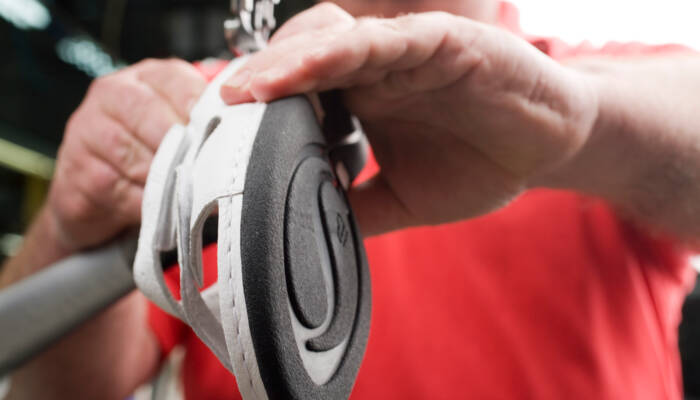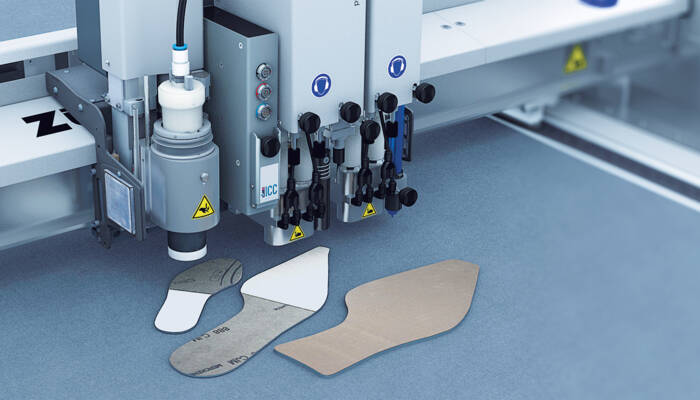
A tale of thrifty Germans and digitalized shoe manufacturing
Germans have something of a reputation for frugality. Sure, it’s a cliché, but there’s a grain of truth to it all the same. The example of the German shoe manufacturer Berkemann demonstrates that a combination of frugality, expertise, and consummate skill in digitalizing processes can propel German shoe manufacturers to the very top. The company has been working to completely digitalize its cutting rooms and relies on digital cutting technology and software from Zünd.
Berkemann has been manufacturing comfortable shoes for over 130 years. Comfort is all about a good fit, high-quality materials, durability, and sustainability. For Christoph Kannengiesser, Head of Technical Projects, comfort is also about “listening to one another, being aware of customer needs, and constantly seeking out opportunities for further improvement”. Kannengiesser is the driving force behind the end-to-end digitalization of shoe manufacturing, in particular with state-of-the-art capture, grading, and cutting technology from Zünd. More on that later.
Berkemann is steeped in tradition. Founded in Hamburg in 1885 by Heinrich Adolf Berkemann, the Berkemann Group today employs around 1,000 people at its production and administration facilities in Germany, Croatia, the Czech Republic, and Hungary.
Berkemann has four production plants in Hungary alone: “In Hungary, the land of shoemakers and famous "Budapest-style" shoes, we manufacture comfort shoes using the craftsmanship and expertise of our specialists. Manufacturing our footwear in the heart of Europe allows us to respond quickly to market demands, while keeping our delivery routes short and supply chains transparent,” explained Managing Director Thomas Bauerfeind at a recent event to mark the 25th anniversary of Berkemann Hungary.

Economically sustainable cutting
Sustainability is a key area of focus at Berkemann and permeates everything related to production. At the end of the day, however, it also needs to make sense economically. As Christoph Kannengiesser, Head of Technical Projects, says, “This is an important aspect of our investment in Hungary. Substituting the strip steel previously used for cutting dies was an important factor in our efforts to digitalize cutting at our plant in Kiskunfélegyháza in Hungary.” However, in our evaluation process, digitalizing the leather grading process was even more of a pressing concern since only digital grading and measuring of leather hides enables repeatable processes downstream.
Nesting processes, on the other hand, have been common at Berkemann for a long time. That is why another criterion in our decision was that nesting with the new Mind software had to be at least as good as our current processes, and preferably even better. “In most instances, we have become more efficient with Mind nesting. We are able to nest parts more effectively on a hide that has been digitally captured and graded beforehand,” explains Kannengiesser.
Digital inspection and virtual marking with MindCUT Diva
Kannengiesser is effusive when it comes to digital grading. Berkemann has invested in two MindCUT Diva systems. “Diva” stands for Digital Inspection and Virtual Annotation. Employees who had to be reassigned after the swing-arm clicker presses were replaced with Zünd cutters can now grade full hides on the Diva system in less than five minutes. “To use the Diva, I still need skilled personnel who knows our collections and is familiar with different qualities of leather and grain direction. These people know exactly how far into the shank areas they can place each pattern.”
Making sure the quality and quantity of leather delivered actually matches what was ordered? According to Kannengiesser, a task that was once nearly impossible has now become routine: “The Diva allows me to photo-optically document and measure any skin. It’s an elegant solution that helps prevent under-deliveries. If we order 500 meters, we’d be happy to receive 505 meters but certainly not 490. And if I’m ordering a premium product, I want to make sure that’s precisely what I’m paying for. MindCUT Diva offers us a powerful tool that does all that. It makes us much more efficient, while allowing us to keep a very close eye on our leather suppliers.”
From manual work to digital production
By introducing these digital solutions, Berkemann is generating enthusiasm for working in the cutting shop among the younger, computer-savvy generation. They prefer working on modern, computer-controlled production systems rather than outdated cutting presses. For staff who had previously been working on those presses, the transition to digital cutting was a major change. “We guided people through the process and gradually familiarized them with their tasks. We received excellent support from Zünd along the way.”
As of the end of 2020, Berkemann has been using a total of eight digital cutting systems from Zünd at its production facilities in Hungary—four Zünd L3 C-56 cutters and two older Zünd LC-2400 cutters. In addition, Berkemann invested in a Zünd G3 L-2500 cutter for cutting synthetic and other rolled materials and is using a Zünd S3 M-1200 cutter in the pattern-design department.
“We have been using Zünd cutters in our Hungarian operations for 20 years, so we’ve gained a lot of experience when it comes to the durability, precision, and service of these machines. If the latter isn’t any good, even the best technology will be of no use to you. Zünd has been taking care of us very well indeed.”

Savings and more savings
Digitalized cutting offers tremendous savings potential. For one thing, it eliminates the need for dies. This alone saves Berkemann around EUR 100,000 a year in strip steel. And making dies also takes time. “Now that we no longer use dies, we’ve been able to shorten our internal production processes by several weeks. We don't have to wait for dies to be made anymore, or spend time setting them up, and so on. Once the file is created and we have the pattern ready to go, we can head straight into production. A whole slew of additional tasks and communication have fallen by the wayside. Before, when we were making a shoe model in different materials, we would have to order up to three different sets of dies. Today, we can do all this virtually and make quick, last-minute changes without having to pay for tooling that isn’t needed, or waste any time.”

Scan-to-order workflows benefitting shoe manufacturers
One special feature of Berkemann’s production process is the scan-to-order workflow. This is an offline process in which hides are digitized and cut pieces are nested on the MindCUT Diva system using Mind software, rather than on the cutter. After visiting with customers, the sales representatives enter the orders on their laptops and transmit them to the head office in Thuringia. Orders are then bundled in the data processing center and forwarded to Purchasing and Supply Chain Management, where the amount of material required to fulfill the orders is calculated.
The square-footage calculations from the CAD system are supplemented with additional factors. The various shoe parts are laid out on the resulting area – provided the available materialis of the same quality and grade – and added up to arrive at the total actual square footage requiredfor the order.
Once the order quantity has been determined, production can begin. Berkemann's production is exclusively make-to-order. The variety of models is enormous, while an order for a particular item can sometimes be as small as 20 pairs. “We consider those cases more sample production than industrial custom manufacturing. Either way, we have to be able to work as flexibly and efficiently as possible. There are other cases where we have higher volumes of up to 2,000 pairs of one article, for example, ashoe model in one color, in 14 different sizes.”
The employee charged with cutting goes to the warehouse with their hide horse, scans the orders, and gathers the necessary material accordingly. At the same time, the cutting job is prepared at the cutter. All the operator has to do is double-click to confirm the job, lay out the barcoded hide on the machine, click on the markings, and cutting begins. “The barcode, which I also scan into the cutter, tells me which hide I have in front of me, and the appropriate nesting is applied automatically. In other words, this is a foolproof process that also prevents further errors. It ensures a very high level of repeatability and accuracy.”
The scan-to-order workflow has made Berkemann much more flexible. With the ability to nest different models on the same material, the company has seen even more increases in productivity. All of this is based on existing CAD data made available for nesting via the Model Importer. To ensure one does not lose track after cutting, the cut parts are illuminated in different colors. “The great thing about projection-assisted parts removal is that we can highlight the different sizes and individual model components we are cutting, by using different colors or making them flash. In practice, we have shown that our investment in Zünd technology has paid off within a year. I don’t think there’s any better way of demonstrating the success of this project.”
